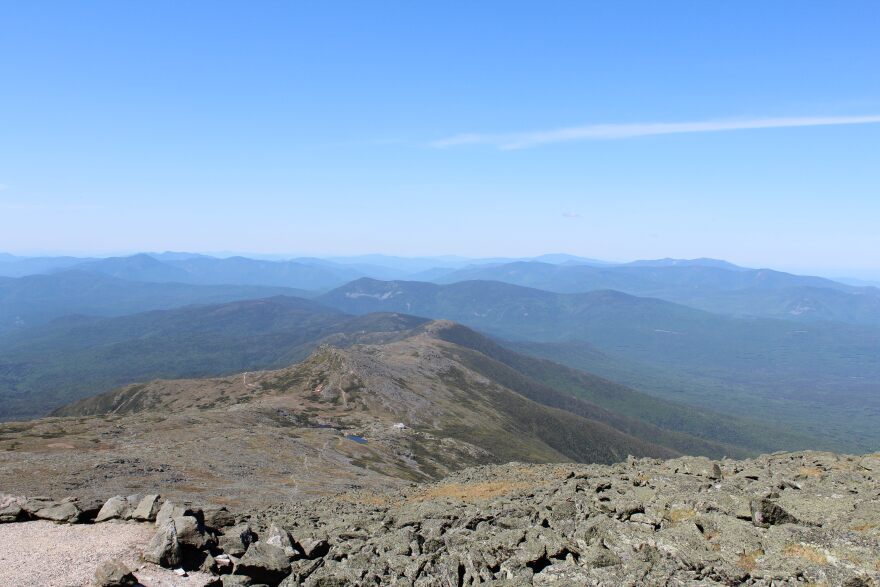A long-running debate is heating up on top of New Hampshire's highest peak. It’s attracting more visitors every year, but some fear its delicate ecosystems are at risk from proposed development and overuse.
Scroll to the bottom of this story to see a timeline of the history of development on Mount Washington.
As you near the top of Mount Washington, the trees get shorter and shorter and finally disappear. This is the highest mountain in the Northeastern U.S., crowned with an alpine zone – a bare, windswept slope of yellow-green grass, endangered flowers and fragile lichens.
Naturalist David Govatski rattles off the flora: “I can see some really nice patches of diapensia,” he says, pointing out cushions of tiny white flowers growing between the rocks. “I can see some deer hair sedge, Bigelow’s sedge, there’s some Lapland Rosebay…”

Govatski first climbed this mountain when he was 14. Since then, he’s hiked every foot of the White Mountain National Forest’s 1,400 miles of trails.
He leads me down one of them, an ankle-bending rocky path that’s part of the Appalachian Trail, and he points down the mountainside.
“That’s actually the area where the hotel would be,” he says. “You can see how close it would be.”
The hotel is a plan from the Mount Washington Cog Railway, which runs tourist trains up the mountain and owns a narrow strip of land for its tracks.
The potential hotel would straddle those tracks in the alpine zone.
The idea has drawn major opposition since it was first made public. That reignited recently after the Cog cleared a maintenance trail along its tracks.

People like David Govatski worried that trail will be used in hotel construction. To build in the alpine, the Cog would need a special county permit. But Govatski worries that if it got one, the hotel would attract more people than the mountain could handle.
“I mean, this is exemplary habitat that you see here, some of the best of its kind in the world for these natural communities,” he says. “To have trails running here, there and everywhere is going to be a real problem.”
As we talk, perched on rocks to protect the grass, Molly Carmody from Massachusetts hikes by on her way to the summit. She thinks this place should remain an escape from society.
“To get to someplace you can only get by the power of your body is pretty cool,” Carmody says.
But right above us, there are hundreds of people in the state park visitor’s center at the summit who did not use their bodies to get here.

Hiking hasn’t been the only way to scale Mount Washington since the 1800s. You can pay to take the train, or drive the hairpin turns of the Mount Washington Auto Road.
They move thousands of people a day and they’re getting more popular every year.
In the gift shop, with windows looking out over wide green valleys and high blue sky, Jodie Heal and her five-year-old son Austin are buying postcards to send home to family in Maine. They drove the mountain last time they visited, and took the train this year.
Heal says she’s not sure they’d have come if the summit had no facilities.
“Especially traveling with children, they don’t always hike very well, so it’s nice when we get up if they’re hungry they can get food, and if they want to get a souvenir, they can,” she says.

Outside, crowds of people take panoramic videos of the view and stand in line for a selfie with the pile of rocks that marks the summit. Cars and motorcycles pull in and out of packed parking lots, and Cog Railway trains chug away down off the mountaintop.
Down at Cog’s base station, I meet the railway’s owner, Wayne Presby. He says his proposed hotel would serve all these visitors – that it could boost this rural economy and ease the strain on other overcrowded mountain facilities.
“I think we’re one of the key pieces for Mount Washington, for tourism in general in the state of New Hampshire,” Presby says.
That’s been truer than ever for the past 15 years, since the fall of the Old Man of the Mountain.
Without the iconic rock face to attract huge numbers of visitors, Presby says, the state has worked to spotlight Mount Washington instead. He says he’s just trying to meet that demand – to provide an alpine experience for everyone, hiker or not.
“People like to visit mountaintops, and not all of them are capable of hiking,” he says. “People need a refuge when the weather gets bad. So I think there’s any number of reasons why there’s a need for additional facilities up there.”

This year, New Hampshire plans to find out exactly how much need there is, with a study the Mount Washington summit’s capacity.
It could help settle some debate over how the state’s signature tourist attraction can be accessible to everyone – and still remain wild.
Timeline: A brief history of development on Mount Washington








